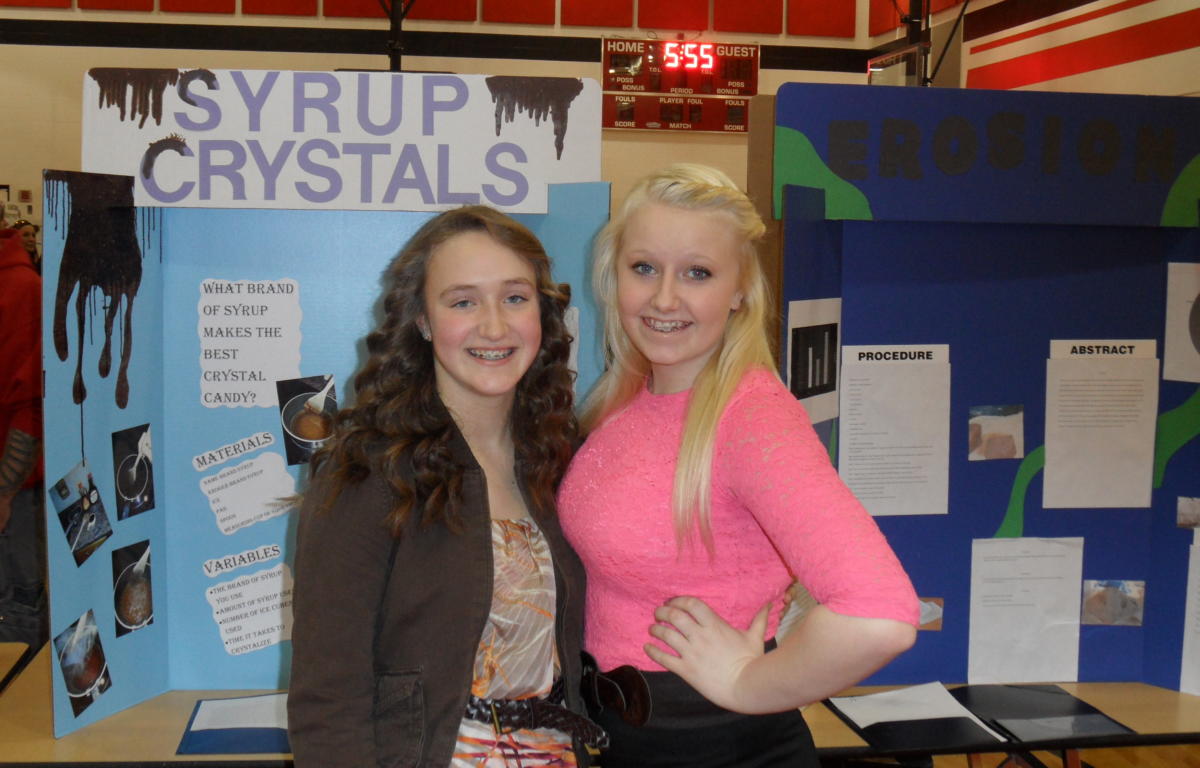By Andrew Walsh
awalsh@wbcowqel.com
Amanda Kent is a biological sciences teacher at Bucyrus, as well as the Science Club advisor, and she was noticeably busy making sure everything and everyone was in position for the Bucyrus Secondary Science Fair.
When she did have a brief lull, she was available for a few breathless seconds to provide some background on this year’s event. Open viewing of the projects was from 5 to 6 p.m. on Wednesday, with the judging commencing at 6.
The science fair is held annually, of which Kent has over seen the last five years, and it is open to kids grades 6 through 12. It is optional for many of them, but a new rule this year sees it as a requirement for the sophomore level physical science students. This accounts for some of the large jump in participation, as last year’s event had 68 projects and 2014 features 150.
Requirement or not, that is a nice boost, and the junior high gymnasium was nearly full of projects on display. Some differences from years past too are that students are much more limited in the props they can display. The restrictions have mostly trimmed it down to a poster board with pictures, and their written report. This does a number of things; firstly, it makes students focus more on the data and scientific method than on fancy props, and secondly, and it keeps these display spaces from becoming overly elaborate and disruptive.
Students graded at a superior at this level will be invited to take part in the district competition, which will be held at OSU-Marion on March 15. Kent added that last year five Bucyrus students attended, with one moving on to the state competition. Results of the judging will be made available Thursday.
 Sarah Lipscomb, a seventh grader, could not wait to elaborate on the subject of her project: The Rubik’s Cube. Her inspiration for this project was watching Aaron Craft’s exhibition with this puzzle on Sportscenter, with her ultimate goal being able to beat his time of 1:13. Sadly, she is still about 26 seconds behind that but she is, “working on it.”
Sarah Lipscomb, a seventh grader, could not wait to elaborate on the subject of her project: The Rubik’s Cube. Her inspiration for this project was watching Aaron Craft’s exhibition with this puzzle on Sportscenter, with her ultimate goal being able to beat his time of 1:13. Sadly, she is still about 26 seconds behind that but she is, “working on it.”
Her project examined different methods of solving the cube, which she taught to four test subjects and timed them on multiple runs, using the average time for comparison. Her control group was a method called the “speed solver” and she matched that with three other methods in a beginner, intermediate, and advanced range. The advanced range method turned out to be the fastest by quite a wide distance and proved her hypothesis.
 Jumping up to a high school level project, Bailey Plumley’s project concerned Solutions, Temperatures, and Osmosis. Bailey, a ninth grader, was intrigued by an experiment he conducted in science class where they placed an egg in vinegar until the shell had completely dissolved. He wanted to test osmosis at different temperatures and in different liquids. He utilized three temperature ranges, as well as three different liquids to conduct his experiments. He placed an egg in each of water, other eggs (these de-shelled of course), and corn syrup. He then had one each of these cups at a heated temperature, room temperature, and cooled. The overwhelming factor in determining how quickly the egg dissolved was the temperature. The higher the temperature, the higher the rate of osmosis.
Jumping up to a high school level project, Bailey Plumley’s project concerned Solutions, Temperatures, and Osmosis. Bailey, a ninth grader, was intrigued by an experiment he conducted in science class where they placed an egg in vinegar until the shell had completely dissolved. He wanted to test osmosis at different temperatures and in different liquids. He utilized three temperature ranges, as well as three different liquids to conduct his experiments. He placed an egg in each of water, other eggs (these de-shelled of course), and corn syrup. He then had one each of these cups at a heated temperature, room temperature, and cooled. The overwhelming factor in determining how quickly the egg dissolved was the temperature. The higher the temperature, the higher the rate of osmosis.
Sophomores Ashley Keener and Mackenzie Whitmore were examining the projects together, but, as was the case with all projects, had individual projects to present. Ashley’s featured one of her favorite subjects: Chocolate. When asked why, she offered up the straightforward,
“I just really like chocolate!”
She tested different types of chocolates for their melting and freezing principles. She discovered that white chocolate both melts and freezes the quickest because it is the least dense. Her hypothesis had been that dark would melt the fastest and milk chocolate would freeze the fastest.
“I did science fair before and didn’t like the subject,” Ashley stated, before grinning, “But I enjoyed this one.”
Mackenzie’s project was different but still in the sugar kingdom. She tested name brand versus store brand syrups for their crystallization properties. Her research yielded that name brand syrups are thicker and crystallize faster, as they typically contain more sugars. Whether this is a good or bad property seems to be in the eye of the beholder.
If Kent’s endless running, and the gymnasium full of projects, are anything to go by, then Bucyrus’ Science Fair engaged a lot of kids in a lot of science. Topics were due way back at the start of the school year in September, and with spring possibly creeping its head into the picture the students have been given the opportunity to show off what they have learned.


